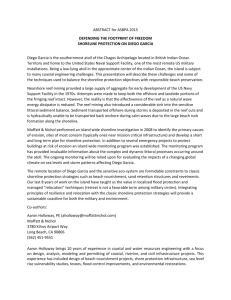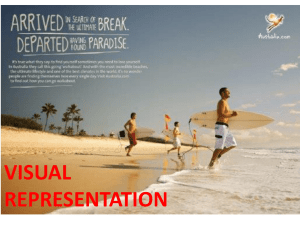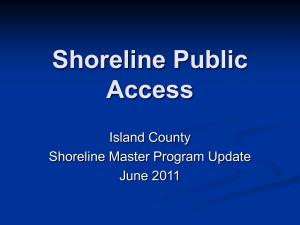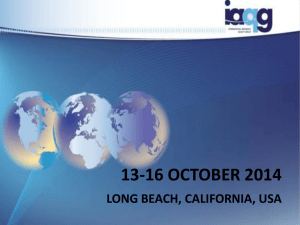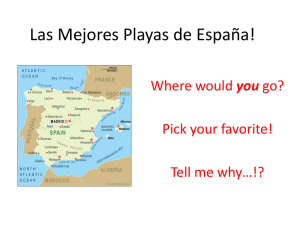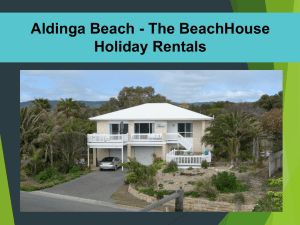SPAWAR Systems Center Pacific
advertisement
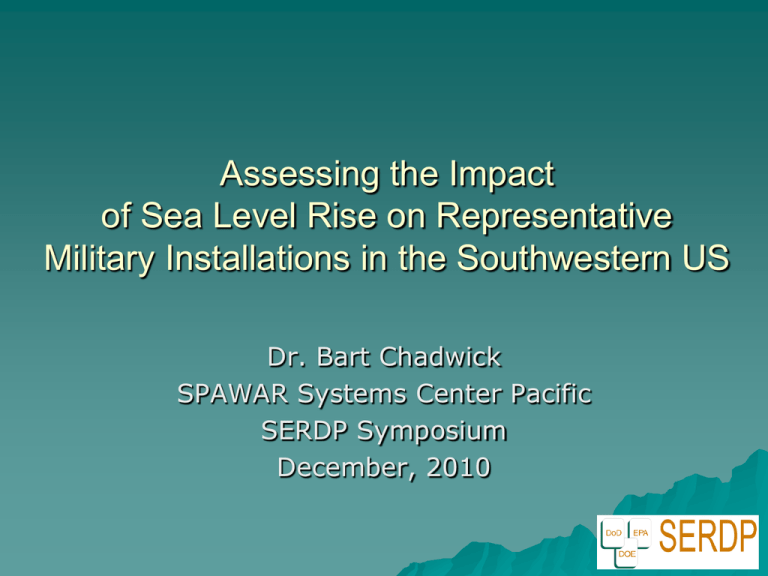
Assessing the Impact of Sea Level Rise on Representative Military Installations in the Southwestern US Dr. Bart Chadwick SPAWAR Systems Center Pacific SERDP Symposium December, 2010 Project Team SPAWAR Systems Center Pacific – Dr. Bart Chadwick, Dr. Pei-Fang Wang, Marissa Brand, William Wild TerraCosta Consulting Group - Dr. Reinhard Flick, Dr. Robert Guza, Dr. William O'Reilly, Dr. Peter Bromirski, Dr. Adam Young, Walter Crampton UCSD: San Diego Supercomputer Center – Dr. John Helly SDSU: Global Change Research Group – Dr. Walt Oechel US Geological Survey – Dr. Tracy Nishikawa Army Corps of Engineers - Dr . Kevin Knutti Moffat-Nichol/Blaylock - Matthew Martinez, Issac Canner 2 Technical Objective Coastal military installation vulnerabilities Region-specific SLR scenarios Southwest US Evaluate & apply framework – Naval Base Coronado – Marine Corps Base Camp Pendleton 3 Installations Marine Corps Base Camp Pendleton Nation’s premier amphibious training base Occupies approximately 125,000 acres along 17 miles of the southern California coast Supports ~41,000 personnel Current value over $3.6 billion Marine Corps Base Camp Pendleton Naval Base Coronado Serves a critical mission to arm, repair, provision, service, train and support the U.S. Pacific Fleet Unique combination of airfields, airspace, training ranges, and installations Supports 21 squadrons, >220 aircraft, 3 carriers, and ~36,000 personnel 4 Assessment Framework – Sources, Pathways and Receptors Sources - key SL drivers for southwest US Pathways – Link sources to receptors via physical impact Receptors common DoDspecific installation elements Site-specific questions and scenarios Sources/Stressors Pathways Local Mean Sea Level Receptors Waterfront structures Subsidence and Uplift Inundation Coastal structures Atmospheric-Oceanic Processes Flooding Buildings Storm Surge Erosion Training and testing lands Precipitation Intrusion Civil Infrastructure Tides Water Level Military and Civilian Personnel Non-Tide Residuals Waves Protective Buffers and Natural resources 5 Assessment Framework - Conceptual Model Flooding, Beach & Cliff Losses - Combinations of MSLR, Climate Variability, Tides, Waves & Runup Maximum Potential Flooding Elevation 6m 4m 3.5 m Episodic Risks PDO 1.5 m Sea Level Today ENSO 2m Ocean Warming + Ice Melt 0m Long-Term Risks Southwest SL Today Southwest SL 2100+ 6 Total WL Sea Level Source Components Sea Level Scenarios - Method B1,A2 Future Climate Scenarios SERDP Prescribed Sea Level for 2100 CCSM3 Global Climate Model Harmonic Tide Model Predictions ACoE Quadratic Model Local Mean Sea Level Curves Local Non-Tide Residuals Local Tides Wave Watch III Model CDIP Model Local Waves & Runup Groundwater Protected Bays and Estuaries Exposed Shorelines 7 Sea Level Scenarios - Combined Combine prescribed future MSL scenarios with SL variability over a range of return periods 100 Tide and non-Tide (CCSM3-A2, 2000-2099) 10 Return Period (Years) Decade 1 Year 0.1 Month 3.0 Week SERDP 2.0 Tide + NTR Day 2.5 Meters (NAVD) 0.01 NRC III 0.001 1.3 2.0 1.4 1.5 1.8 1.9 2.0 2.1 2.2 2.3 2.4 Water Level (m NAVD) SL Variability vs. Return Period NRC I 100 1.0 SS0160 Total Runup MSL = 0.774 m 10 2020 2040 2060 2080 2100 Include relevant SL components based on exposure - groundwater, protected bays, exposed beaches Return Period (Years) 1.7 NRC II 1.5 0.5 2000 1.6 Decade 1 Year 0.1 Month Week 0.01 Tide + NTR +Runup Day 0.001 1.0 1.5 2.0 2.5 Water Level (m NAVD) 3.0 3.5 4.0 8 Coastal System Delineation Compile geophysical system data Compile installation data Integrate within a geospatial visualization and analysis system – Capability for superimposing hydraulically-connected water levels 9 Coastal System Delineation Digital terrain with GIS infrastructure overlays “Dose-Response” type curves for installation sensitivity to sea level rise Naval Base Coronado Cummulative Flooding (% of installatiton) 100% 80% Inland Buildings/Infra 60% Airfields Ammunition Bunkers Stormwater Conveyance 40% Near-Shore Buildings/Infra Ship-Shore Interface Beach Rec Facilities Beach Training Facilities 20% Beach Training Areas 0% MSL 0 1 2 3 4 5 Total Water Level (m NAVD) 6 7 8 Physical Effects Long-Term - Exposed Shorelines Shorelines (Seasonal Variations and Sand Budget Effects) Long-term equilibrium shoreline Seasonal variability historical data Constrain with sand budget Translate shoreline change to future terrain model Future Conditions (2100) Current Conditions Future Beach (Land) Seasonal variations ~ 40 meters between summer and winter Future Summer Shoreline Beach line if sand budget is positive Current Winter Shoreline Ocean Current Summer Shoreline Future Mean Shoreline Beach Retreat at 2100 from SLR (Brunn’s Rule) 160 PN1110 140 Beach Width (m NAVD) Future Winter Shoreline Beach (Land) Current Mean Shoreline 120 100 80 60 40 20 0 1940 Historical Profiles "Bruun-ish" Model (NRC II) + Seasonal 1960 1980 2000 2020 2040 2060 2080 2100 11 Assessment of Vulnerability Location/ Return Period Condition NBC SS0160 With Runup Defined scenarios and stakeholder identified key vulnerabilities Screening-level assessment accounts for MSL+variability assumes un-modified shoreline Potential impact to key receptors from problem formulation Highlight scenarios under which these receptors would be impacted MCBCP PN1110 With Runup Week Month Year Decade Century Week Month Year Decade Century Baseline (m NAVD) 2.40 2.80 3.39 3.63 3.80 1.99 2.36 2.80 3.17 3.34 0.5 (>2045) 2.90 3.30 3.89 4.13 4.30 2.49 2.86 3.30 3.67 3.84 Future Increase in MSL (m) 1.0 1.5 (>2070) (>2085) 3.40 3.90 3.80 4.30 4.39 4.89 4.63 5.13 4.80 5.30 2.99 3.49 3.36 3.86 3.80 4.30 4.17 4.67 4.34 4.84 2.0 (>2100) 4.40 4.80 5.39 5.63 5.80 3.99 4.36 4.80 5.17 5.34 12 NBC Baseline MHHW NBC MSL+1.0m Yearly Return NBC MSL+0.5m Yearly Return NBC MSL+2.0m Yearly Return 13 Summary DoD is developing methodologies to evaluate vulnerability and adaptation at coastal installations These risk-based methods incorporate quantification of stressors, pathways and receptors Vulnerability to sea level in the southwest is related to the cooccurrence of high tides, high waves, surge and El Niño conditions Sea level rise can dramatically influence the return period of what today are viewed as “extreme events” Vulnerability to these events can occur via flooding, inundation, erosion, intrusion or water level itself Each installation has a unique sensitivity to these conditions 14
